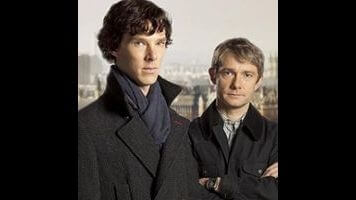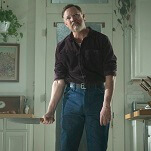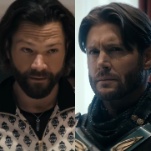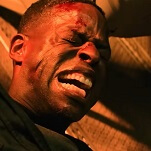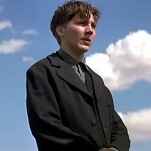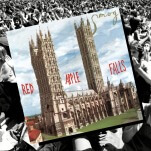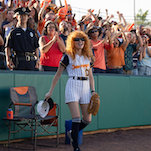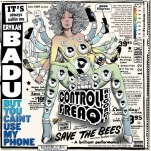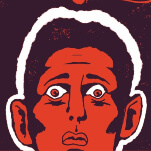Here is the line that remains with me from this episode of Sherlock: “Once you’ve ruled out the impossible, whatever remains, however improbable, must be true.” It’s a slightly altered version of a famous quotation from Arthur Conan Doyle’s Holmes canon. When Holmes says this to Dr. Watson in the original source, The Sign Of The Four, he’s trying to disabuse Watson of preconceptions as they confront what appears to be an impossible break-in: A man entered a room 60 feet above the ground without using any doors or windows. Dr. Watson is preoccupied with the impossibility of the feat; Holmes’ point is that Watson’s conception of what’s possible has no bearing on the facts of the matter.
In “The Hounds Of Baskerville,” Sherlock utters this same line as he raves to Watson, in a drug-induced delirium, about the big red-eyed dog that he saw. And when Sherlock says it, Watson asks, “What does that mean?” It’s a fair question, because the answer is that it doesn’t mean much. The reason that the original quote is so famous is because in its original context, it’s such an elegant summation not just of Sherlock Holmes’ approach but of scientific inquiry as a whole. All of that elegance is stripped away here, where it serves primarily as a fancy way for Sherlock to say, “I realize it sounds crazy, but I know what I saw, damn you!”
The misuse of the quote is emblematic of “The Hounds Of Baskerville,” which takes Doyle’s famous Holmes novel and recasts it as a platform for unconvincing psychological horror. This is an uncharacteristically poor outing for the program, which is especially disappointing given how brief the seasons are and how little Sherlock we get to enjoy already. But at least “The Hounds Of Baskerville,” by working so poorly, provides a contrast that shows why the show usually works so well.
The primary shortfall of “The Hounds Of Baskerville” is that there is so much nothing where there ought to be something. The episode has mystery, but it’s a mystery driven by the absence of facts. The episode is rife with long sections of emptiness. The client, Henry Knight (Russell Tovey) takes a good 10 minutes to say that his father was killed by something with large footprints. Sherlock and Watson stroll through empty labs. Sherlock and Henry get freaked out by shaky-camera nothingness in the middle of the moor. Henry freaks out at shaky-camera nothingness in his backyard. Watson reenacts the kitchen scene from Jurassic Park, minus the dinosaurs, in the Baskerville complex.
And of course, on a lighter note, there’s the stretch in which Watson chases down a distant set of flashing lights as a possible lead, as the show takes us on an inordinately long journey for an “it’s just people screwing in their car!” red-herring gag. It’s emblematic of the many instances in which this episode goes on a long walk for an awfully small drink of water.
That emptiness is portrayed with a purpose, of course. The mind can go to disturbing places when there’s no discernible, rational reality on which it can gain purchase, and “The Hounds Of Baskerville” is playing off of that. It’s a promising basis for an austere psychological thriller—just not for an episode of Sherlock.
The show is at its best not when the mystery emerges from an absence of facts, but when there’s a preponderance of facts that don’t add up—or, more accurately, when there are facts that add up imperfectly to the wrong result, and only Sherlock’s mind can make them all fit. That doesn’t strike me as a terribly restrictive formula—Doyle certainly got plenty of mileage out of it—even if I do admire Sherlock for trying something different.
The thin soup of the mystery in “The Hounds Of Baskerville” is made even worse by lifeless execution. The ancillary characters consistently fail to make much of an impression, sliding out of memory as soon as they leave the screen. The gape-mouthed Henry Knight spends the majority of his screentime blubbering and moaning. When Sherlock says that he’ll take the case because Henry said, “They were the footprints of a gigantic hound,” it makes a certain kind of sense, as it’s the only marginally interesting thing that Henry utters in the entire 90 minutes.
Aside from providing another hollow reference to the original Hound Of The Baskervilles story, Henry’s therapist, Dr. Mortimer, seems to exist so that she can be nearly shot by Henry. Her presence is otherwise inconsequential. It’s a similar situation with Inspector Lestrade, who shows up out of contractual obligation, and Mycroft Holmes, who provides an implausible (and glossed-over) deus ex machina by getting Sherlock back into Baskerville a second time.
Then there’s the evil scientist of evil, Dr. Frankland, the “old friend” of Henry’s murdered father who might as well have “HEY EVERYONE, I’M THE KILLER!” tattooed on his face. He’s a bit lacking in subtlety. For instance, when he killed Henry’s father for discovering the existence of Frankland’s dastardly chemical experiments, Frankland apparently chose to wear a T-shirt featuring the enormous logo of the secret project he was trying to conceal.
As for that secret project, it doesn’t provide much of a reveal. All throughout the episode, we’re reminded of the popular theory that the horrors witnessed in the mists of Dartmoor are the result of genetic experimentation by a shadowy government outfit. And in the end, the cause proves to be chemical experiments by a shadowy government outfit, a distinction without a practical difference.
While there’s a briefly intriguing mystery about the vector of the craze-inducing drug, the solution here is similarly unsatisfying: Frankland pumped gas into the air. That payoff feels more suited to Adam West’s Batman than Benedict Cumberbatch’s Sherlock. The closing scene, in which Moriarty has scrawled “SHERLOCK” all over the walls of his ultra-modern prison cell, is similarly hokey.
“The Hounds Of Baskerville” seems to be obsessed more than other episodes with a painstaking modernization of elements from its source material. It seems especially proud, for instance, of substituting a high-tech military complex for the manor in the original Hound Of The Baskervilles. While such changes can be inventive, these revisions can’t sustain a story on their own. They’re window dressing.
At its best, Sherlock succeeds not because it’s a modernization of the Doyle canon but because it’s a lively reinterpretation. The friendship between Holmes and Dr. Watson was rarely a point of interest in Doyle’s stories, yet Steven Moffat and Mark Gatiss have spun it into a complex, charged relationship full of intrigue and personal drama. It’s that type of fearless creativity—as opposed to mere revision—that makes Sherlock great. It’s telling, then, that this episode follows the lead of the original story by keeping Sherlock and Watson separate for long chunks of time, scenes during which the show, not coincidentally, feels limp.
In a way, it could be Moffat and Gatiss’ Holmes obsession that led Sherlock astray here. The Hound Of The Baskervilles is arguably Doyle’s most venerated single work, so any adaptation of it must be a daunting task. It would be natural to end up with an outing like “The Hounds Of Baskerville,” which is so preoccupied with its relationship to the mother text that it loses track of the fascinating mythology Sherlock has built up in its own right—a show imprisoned, rather than inspired, by its own muse.
Stray observations:
- So how exactly does Mycroft get Sherlock back into Baskerville? Maybe he called up and said, “This is Mycroft Holmes, and you’ll let my brother in there, or I’ll have your job.” But if that’s the case, wouldn’t Major Barrymore have realized that Dr. Frankland was lying when he vouched for the identity of “Mycroft Holmes” during Sherlock’s first intrusion? I would think that lying about the identity of an intruder would be frowned upon at a top-secret military installation. In order for the second visit to make sense, either Sherlock has to maintain the lie that he’s Mycroft—and it’s hard to imagine the real Mycroft going along with that—or Frankland is exposed.
- I found Sherlock’s “mind palace” Minority Report routine to be over the top, but I also appreciate how hard it must be to illustrate a detective’s thought process on screen, so I’m glad the show continues to experiment with new ideas on this front.
- Nitpick: The resolution of Knight’s “Liberty In” hallucination leaves something to be desired, as the two-letter postal abbreviation for Indiana is always written in all caps—otherwise it would be “Liberty, Ind.” I’ll chalk this up to a combination of artistic license and forgivable transatlantic ignorance.
